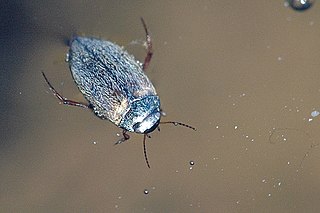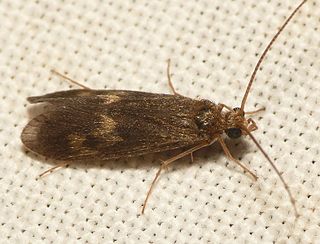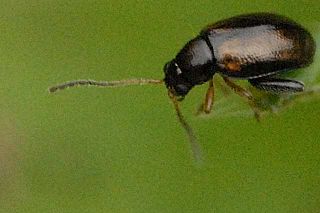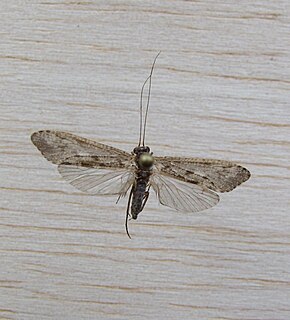Related Research Articles

The ovipositor is a tube-like organ used by some animals, especially insects for the laying of eggs. In insects, an ovipositor consists of a maximum of three pairs of appendages. The details and morphology of the ovipositor vary, but typically its form is adapted to functions such as preparing a place for the egg, transmitting the egg, and then placing it properly. For insects, the organ is used merely to attach the egg to some surface, but for many parasitic species, it is a piercing organ as well.

Tettigoniidea is an infraorder of the order Orthoptera, with six extant families.
Oligoneuriidae is a family of brushleg mayflies in the order Ephemeroptera. There are at least 13 described species in Oligoneuriidae.

Pisciforma is a suborder of mayflies in the order Ephemeroptera. There are at least 410 described species in Pisciforma.

Hydroporini is a tribe of predaceous diving beetles in the family Dytiscidae. There are at least 730 described species in Hydroporini.

Neureclipsis is a genus of tube maker caddisflies in the family Polycentropodidae. There are at least 8 described species in Neureclipsis.
Heterocampinae is a subfamily of prominent moths in the family Notodontidae. There are at least 60 described species of Heterocampinae in North America.
Parthenicus is a genus of plant bugs in the family Miridae. There are at least 70 described species in Parthenicus.
Orthotylinae is a subfamily of plant bugs in the family Miridae. There are at least 650 described species and at least 70 genera in Orthotylinae. The Orthotylinae have traditionally been diagnosed by their possession of lamellate, apically divergent parempodia.

Phyllotreta is a genus of flea beetles in the family Chrysomelidae. There are at least 40 described species in Phyllotreta.

Acritus is a genus of clown beetles in the family Histeridae. There are at least 110 described species in Acritus.

Hydropsyche is a genus of netspinning caddisflies in the family Hydropsychidae. There are at least 260 described species in Hydropsyche.

Cuterebra fontinella, the mouse bot fly, is a species of New World skin bot fly in the family Oestridae. C. fontinella is typically around 1 mm long with a black and yellow color pattern. C. fontinella develops by parasitizing nutrients from its host, typically the white-footed mouse. C. fontinella has even been known to parasitize humans in rare cases. Individuals parasitized by C. fontinella will develop a large bump on the skin that is indicative of parasitization.
Cuterebra bajensis is a species of new world skin bot flies in the family Oestridae.
Cuterebra emasculator, the squirrel bot fly, is a species of new world skin bot fly in the family Oestridae. The species was first described by Asa Fitch in 1856. It is an internal parasite of chipmunks and tree squirrels in the eastern United States. The species name comes from the belief that larvae ate the testicles of chipmunks.
Cuterebra cuniculi is a species of new world skin bot fly in the family Oestridae.
Cuterebra mirabilis is a species of new world skin bot fly in the family Oestridae.
Cuterebra abdominalis is a species of new world skin bot fly in the family Oestridae.
Cuterebra lepusculi, the cottontail rabbit botfly, is a species of new world skin bot fly in the family Oestridae.
Cuterebra americana, the woodrat bot fly, is a species of new world skin bot fly in the family Oestridae.
References
- ↑ "Cuterebra austeni Species Information". BugGuide.net. Retrieved 27 January 2018.
- ↑ "Cuterebra austeni Report". Integrated Taxonomic Information System. Retrieved 27 January 2018.
